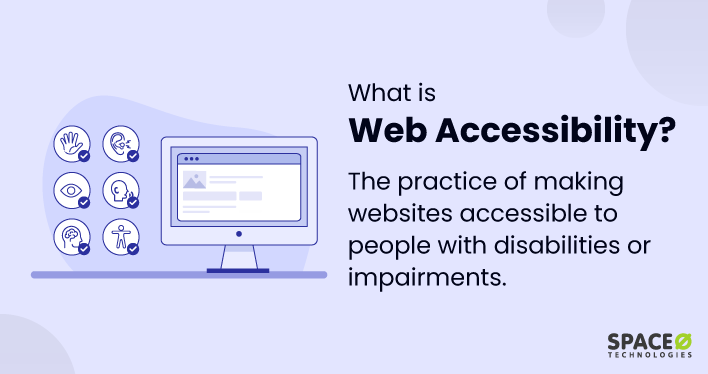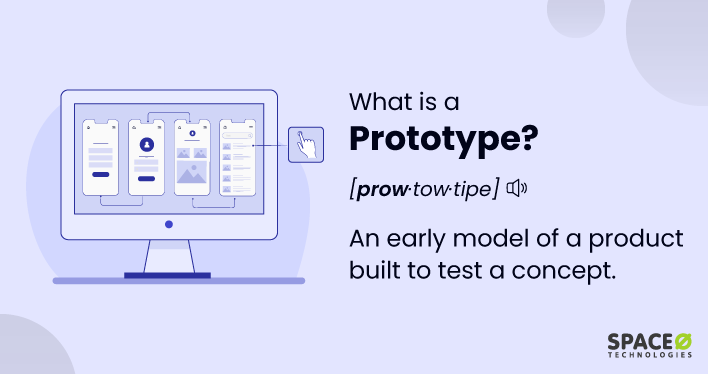Table of Contents
What is Web Accessibility?
Web accessibility is the practice of designing and developing websites, tools, and technologies in such a way that people with disabilities can use them without any difficulties. This means ensuring that all users, regardless of their abilities, can perceive, understand, navigate, and interact with the web, as well as contribute to it.
For example, let’s say you are designing a website for an online store that sells clothing. A person with a visual impairment may not be able to see the images of the clothes on your website, but they still want to shop and make a purchase. By providing alt text descriptions for each image, you can ensure that a screen reader can read out the description of the clothing item.
Let’s check how web accessibility is beneficial.
Why is Web Accessibility Important?
Web accessibility is important because it ensures that all users, including those with disabilities, can access and use the world wide web. Here are the 5 key points that describe the importance of web accessibility
By making your website more accessible, you can:
- Reach a Wider Audience: Web accessibility ensures that all users, including those with disabilities, can access and use your website. This means that you can reach a larger audience and provide equal opportunities for all users to engage with your content.
- Improve User Experience: Web accessibility guidelines promote usability and user experience for all users, including those with people with disabilities. By making your website more accessible, you can improve the overall user experience for all users, regardless of the web browsers or assistive technology they use. This is crucial as inaccessible websites create barriers for people with disabilities, preventing them from accessing important information and services online
- Meet Legal Requirements: In many countries, including the United States, web accessibility is required by law. By ensuring that your website is accessible, you can avoid legal issues and potential lawsuits.
- Increase Website Usability: Accessibility guidelines promote usability and navigation, making it easier for users to find and interact with your website’s content.
- Enhance Search Engine Optimization: Web accessibility can also improve your website’s search engine optimization (SEO) by making it easier for search engines to crawl and index your website’s content.
So, you know the benefits, let’s even check how you can increase your website accessibility.
How to Make Your Website Accessible
Making your website accessible involves implementing certain practices and techniques that ensure people with disabilities can use your website without any barriers. By integrating accessibility considerations into your development process, you can create a website that is both functional and usable for all. Here are some key steps you can take to make your website more accessible.
- Use Alternative Text: Adding alternative text to images helps users with visual impairments understand the content of the image.
- Provide Keyboard Navigation: Many people with disabilities rely on keyboard navigation to access and interact with websites. Make sure all interactive elements on your accessible sites, such as menus and buttons, can be accessed via the keyboard.
- Ensure Color Contrast: Users with visual impairments may have difficulty distinguishing between similar colors. Make sure the contrast between foreground and background colors is sufficient to ensure legibility.
- Use Descriptive Headings: Use headings to break up content and make it easier for screen reader users to navigate your website. Use descriptive and informative headings that accurately describe the content of the section.
- Add Captions and Transcripts: Adding captions and transcripts to videos and audio files makes the content accessible to users with hearing impairments.
- Provide Clear and Simple Language: Use clear and simple language that is easy to read and understand. Avoid using jargon or complex words that may be difficult for some users to understand.
- Test Your Website: Use accessibility testing tools to identify any accessibility problems or issues on your website. These tools can help you describe accessibility solutions for problems such as missing alternative text, keyboard navigation issues, or color contrast issues.
It’s also a good practice to create a prototype of your website during the testing phase. This allows you to test the functionality of your website and receive feedback before the website goes live. If you want to understand more about how a prototype can help, refer to our post explaining the meaning of prototype. Reading this you will have a detailed understanding of its importance.
By implementing these practices, you can make your website more accessible to users with disabilities, providing a better user experience for all users, including those using Accessible Rich Internet Applications (ARIA) technologies.
What are Some Examples of Web Accessibility Techniques?
Here are the 5 core examples of web accessibility techniques you can implement to remove accessibility barriers and ensure that all users can access and interact with your online web content.
- Use descriptive and meaningful text for links, such as “Read more about web accessibility” instead of “Click here”.
- Ensure that all images have meaningful alternative text (alt text) that can be read by screen readers.
- Use headings (H1, H2, H3, etc.) to structure your content, making it easier for users to navigate and understand.
- Choose colors with sufficient contrast between the text and background, ensuring that users with low vision can read the content.
- Design forms with clear labels and instructions, and provide error messages that help users understand and correct any mistakes.
5 Ways to Test Your Website for Accessibility
Here are the 5 important ways to test the scalability of your website.
Use Accessibility Evaluation Tools
There are a variety of tools available that can help you test your website’s accessibility, such as screen readers, color contrast checkers, and keyboard navigability testers, all of which adhere to tool accessibility guidelines.
Check Contrast Ratios
Make sure that the contrast ratios between text and background colors meet accessibility standards. A good rule of thumb is to use a contrast ratio of at least 4.5:1 for small text and 3:1 for large text.
Test Keyboard Navigation
Ensure that all elements on your accessible sites can be accessed and navigated using a keyboard alone, without the need for a mouse or other pointing device.
Use Alternative Text for Images
Provide alternative text for all images on your website, which allows users with visual impairments to understand the content of the image.
Test With a Screen Reader
Create accessible websites by testing them with a screen reader. This tool enables users who are blind or have low vision to navigate your website using text-to-speech or refreshable braille displays.
By following these steps, you can describe accessibility solutions to ensure that your website is accessible to all users, regardless of their abilities or disabilities.
Web accessibility is a crucial aspect of designing and developing websites, ensuring that all users, including those with disabilities, can access and interact with online content.
By following web content accessibility guidelines such as the WCAG set by the Web Accessibility Initiative (WAI) and implementing accessibility best practices, you can create a more inclusive digital experience for everyone. Remember to keep up-to-date on web accessibility trends and resources to maintain a truly accessible website




